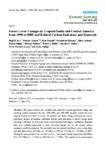Use este identificador para citar ou linkar para este item:
http://www.alice.cnptia.embrapa.br/alice/handle/doc/924822Registro completo de metadados
| Campo DC | Valor | Idioma |
|---|---|---|
| dc.contributor.author | EVA, H. D. | pt_BR |
| dc.contributor.author | ACHARD, F. | pt_BR |
| dc.contributor.author | BEUCHLE, R. | pt_BR |
| dc.contributor.author | MIRANDA, E. E. de | pt_BR |
| dc.contributor.author | CARBONI, S. | pt_BR |
| dc.contributor.author | SELIGER, R. | pt_BR |
| dc.contributor.author | VOLLMAR, M. | pt_BR |
| dc.contributor.author | HOLLER, W. A. | pt_BR |
| dc.contributor.author | OSHIRO, O. T. | pt_BR |
| dc.contributor.author | ARROYO, V. B. | pt_BR |
| dc.contributor.author | GALLEGO, J. | pt_BR |
| dc.date.accessioned | 2012-05-17T11:11:11Z | pt_BR |
| dc.date.accessioned | 2012-05-17T11:11:11Z | pt_BR |
| dc.date.available | 2012-05-17T11:11:11Z | pt_BR |
| dc.date.available | 2012-05-17T11:11:11Z | pt_BR |
| dc.date.created | 2012-05-17 | pt_BR |
| dc.date.issued | 2012 | pt_BR |
| dc.identifier.citation | Remote Sensing, v. 4, p. 1369-1391, 2012. | pt_BR |
| dc.identifier.isbn | 2072-4292 | pt_BR |
| dc.identifier.uri | http://www.alice.cnptia.embrapa.br/alice/handle/doc/924822 | pt_BR |
| dc.description | This paper outlines the methods and results for monitoring forest change and resulting carbon emissions for the 1990-2000 and 200-2005 periods carried out over tropical Central and South America. To produce our forest change estimates we used a systematic sample of medium resolution satellite data processed to forest change maps covering 1230 sites of 20 km by 20 km, each located at the degree confluence. Biomass data were spatially associated to each individual sample site so that annual carbon emissions could be estimated. For our study area we estimate that forest cover in the study area had fallen from 763 Mha (s.e. 10 Mha) in 1990 to 715 Mha (s.e. 10 Mha) in 2005. During the same period other wooded land (i.e., non-forest woody vegetation) had fallen from 191 Mha (s.e. 5.5 Mha) to 184 Mha (s.e. 5.5 Mha). This equates to an annual gross loss of 3.74 Mha·y−1 of forests (0.50% annually) between 1990 and 2000, rising to 4.40 Mha·y−1 in the early 2000s (0.61% annually), with Brazil accounting for 69% of the total losses. The annual carbon emissions from the combined loss of forests and other wooded land were calculated to be 482 MtC·y−1 (s.e. 29 MtC·y−1) for the 1990s, and 583 MtC·y−1 (s.e. 48 MtC·y−1) for the 2000 to 2005 period. Our maximum estimate of sinks from forest regrowth in tropical South America is 92 MtC·y−1. These estimates of gross emissions correspond well with the national estimates reported by Brazil, however, they are less than half of those reported in a recent study based on the FAO country statistics, highlighting the need for continued research in this area. | pt_BR |
| dc.language.iso | por | pt_BR |
| dc.rights | openAccess | pt_BR |
| dc.subject | Carbon emissions | pt_BR |
| dc.title | Forest Cover Changes in Tropical South and Central America from 1990 to 2005 and Related Carbon Emissions and Removals. | pt_BR |
| dc.type | Artigo de periódico | pt_BR |
| dc.date.updated | 2014-01-06T11:11:11Z | pt_BR |
| dc.subject.nalthesaurus | deforestation | pt_BR |
| dc.subject.nalthesaurus | monitoring | pt_BR |
| dc.subject.nalthesaurus | remote sensing | pt_BR |
| dc.subject.nalthesaurus | tropics | pt_BR |
| dc.format.extent2 | p. 1369-1391. | pt_BR |
| riaa.ainfo.id | 924822 | pt_BR |
| riaa.ainfo.lastupdate | 2014-01-06 | pt_BR |
| dc.contributor.institution | HUGH D. EVA, JRC; FRÉDÉRIC ACHARD, JRC; RENÉ BEUCHLE, JRC; EVARISTO EDUARDO DE MIRANDA, CNPM; SILVIA CARBONI, JRC; ROMAN SELIGER, JRC; MICHAEL VOLLMAR, JRC; WILSON ANDERSON HOLLER, SGTE; OSVALDO TADATOMO OSHIRO, CNPM; VICTOR BARRENA ARROYO, UNIVERSITY LA MOLINA; JAVIER GALLEGO, JRC. | pt_BR |
| Aparece nas coleções: | Artigo em periódico indexado (CNPM)  | |
Arquivos associados a este item:
| Arquivo | Descrição | Tamanho | Formato | |
|---|---|---|---|---|
| Oswaldoremotesensing.pdf | 1,01 MB | Adobe PDF |  Visualizar/Abrir |









